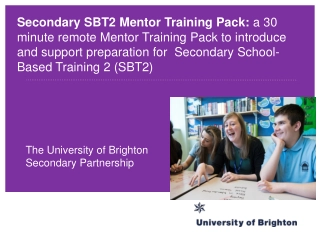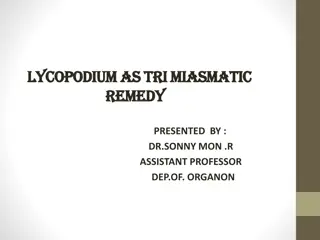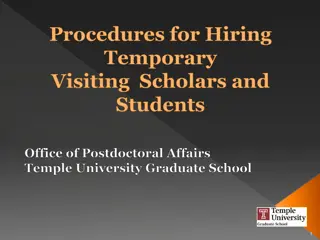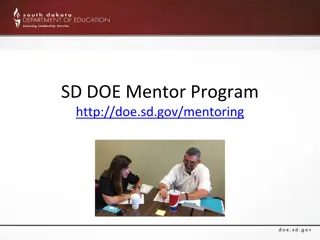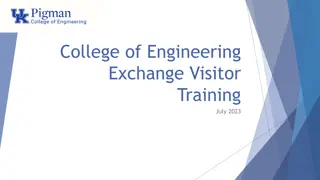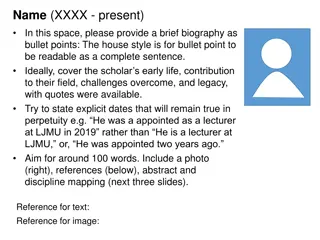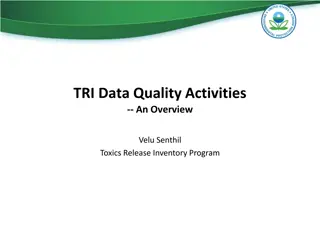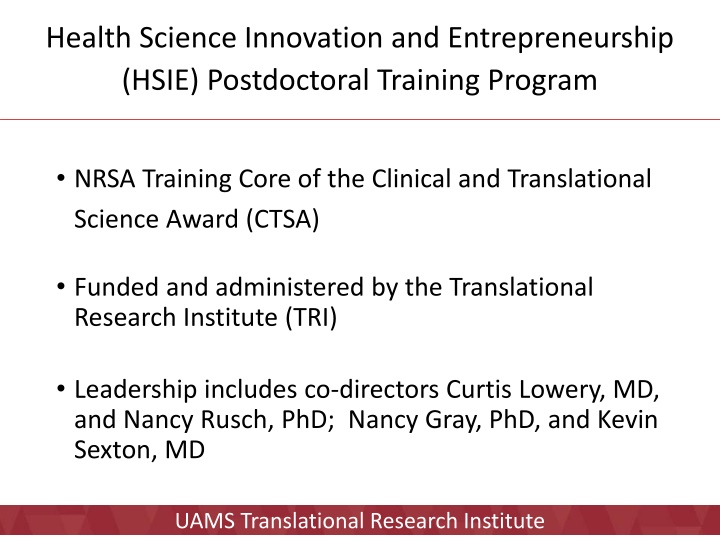
HSIE Training Program in Biomedical Innovation and Entrepreneurship
The Health Science Innovation and Entrepreneurship (HSIE) Training Program at UAMS focuses on accelerating biomedical discoveries through entrepreneurship principles. Postdoctoral fellows gain valuable skills to translate innovations into clinical benefits, enhancing their research training. The program offers a Graduate Certificate and valuable partnerships with industry and business faculties. Led by experienced co-directors, the HSIE program aims to broaden scholars' vision in improving health outcomes through collaborative team science and entrepreneurial strategies.
Download Presentation

Please find below an Image/Link to download the presentation.
The content on the website is provided AS IS for your information and personal use only. It may not be sold, licensed, or shared on other websites without obtaining consent from the author. If you encounter any issues during the download, it is possible that the publisher has removed the file from their server.
You are allowed to download the files provided on this website for personal or commercial use, subject to the condition that they are used lawfully. All files are the property of their respective owners.
The content on the website is provided AS IS for your information and personal use only. It may not be sold, licensed, or shared on other websites without obtaining consent from the author.
E N D
Presentation Transcript
Health Science Innovation and Entrepreneurship (HSIE) Postdoctoral Training Program NRSA Training Core of the Clinical and Translational Science Award (CTSA) Funded and administered by the Translational Research Institute (TRI) Leadership includes co-directors Curtis Lowery, MD, and Nancy Rusch, PhD; Nancy Gray, PhD, and Kevin Sexton, MD UAMS Translational Research Institute
Why the HSIE Training Program? The goal of the HSIE training program is to broaden a scholar s vision of using entrepreneurship principles and team science to accelerate biomedical discoveries into improved health outcomes. It serves to equip postdoctoral fellows with the knowledge and skillset to translate innovations into clinical benefit and is a value-added extension to the postdoctoral fellow s primary research training. UAMS Translational Research Institute
Graduate Certificate in Health Science Innovation and Entrepreneurship 15- credit graduate certificate for postdoctoral fellows Two-year program (4 postdoc scholars enter each year) Value-added training in addition to the primary research project Partnership between faculty at UAMS, BioVentures, and the Sam Walton College of Business at UA Fayetteville. UAMS Translational Research Institute
HSIE Program Leadership Nancy Rusch, Ph.D. and Curtis Lowery, M.D. Program Co-Directors Pamela Kahler, B.A. Program Manager UAMS Faculty Nancy Gray, Ph.D. Nancy Rusch, Ph.D. Curtis Lowery, M.D. Kevin Sexton, M.D. UA Fayetteville Faculty Carol Reeves, Ph.D. Paul Mlakar, Jr., M.B.A. UAMS Translational Research Institute
NRSA Training Core HSIE Training Program The four HSIE Scholars and their research mentors are: Samir Jenkins, PhD (nanomaterials, stem cell differentiation) Mentor: Robert Griffin, Ph.D. Astha Malhotra, PhD (3-D printing and tissue regeneration) Mentors: Jay Mehta, M.D., Ph.D. Melody Penning, PhD (algorithms to predict adverse events) Mentor: Fred Prior, Ph.D. Aaron Storey, PhD (Mass spec ID of bacteria in synovial fluid) Mentor: Ricky Edmondson, Ph.D. UAMS Translational Research Institute
Value added for HSIE postdoc scholars and their primary research mentors Dollar value of 2-year program 170K 100-110K in NIH stipend support 40K for tuition and fees 20K for health insurance and program-related costs 3K extra to attend meetings related to HSIE UAMS Translational Research Institute
Value added for HSIE postdoc scholars and their primary research mentors Non-dollar Value of the HSIE Program Diversify your training portfolio Enhance your job competitiveness Enhance your job satisfaction Develop a UAMS technology Build a community of entrepreneurs UAMS Translational Research Institute
In the works. Earn 9 credits in the MBA program at UA Fayetteville Dilemma that UAMS postdocs more than one year beyond obtaining their PhD degree could not enter the business team competitions Working with Vikas Anand, PhD, Executive Director of MBA Programs and Graduate Innovation at UA s Walton College of Business, to allow our postdoc scholars to be enrolled as MBA students
What are the Components of the Program? UAMS Translational Research Institute
The Components of the HSIE Training Program? Year 1 Semester 1 HSIE 6100 Snapshot Sessions (4 cr) HSIE 6200 Seminar Series (1 cr) *Seminar series continues thru Year 1 Semester 2 MGMT 5213 Foundations of Business for Entrepreneurs (3 cr) UAMS Translational Research Institute
The Components of the HSIE Training Program? Year 2 Semester 1 MGMT 5323 New Venture Development (3 cr) HSIE 6200 Seminar Series (1 cr) *Seminar series continues thru Year 2 Semester 2 MBAD 5413 Partnering Project (3 cr) UAMS Translational Research Institute
What are the Components of the Program? UAMS Translational Research Institute
Snapshot Sessions (4 credits of Independent Study) Guided by your Coaching Team composed of your research mentor, two HSIE leaders, and 1-2 HSIE program faculty members Guided by your IDP (Individual Development Plan) https://myidp.sciencecareers.org/ Evaluate your skills and interests. Evaluate options. Set goals. Outline strategies to achieve them with your Coaching Team. Goal is to identify a biomedical discovery around which you can develop a business plan in Year 2. UAMS Translational Research Institute
What are the Components of the Program? Formulate IDP UAMS Translational Research Institute
What does successful HSIE training look like? Program completion rate and duration of postdoc training (HSIE training should not prolong postdoc) Research and HSIE-related presentations and publications New collaborations/research teams at UAMS and UAMS-UA Innovations (patents, services, products, start-up companies) Careers after participation in the program UAMS Translational Research Institute
What does success look like at the macro level? Mission of the CTSA grant: Accelerate scientific discoveries into clinical practice to improve the health challenges of rural and underrepresented populations. Keep the mission of the CTSA grant in mind as you develop your biomedical discovery. Nanomaterials/stem cell differentiation 3-D printing and tissue regeneration Algorithms to predict adverse events Mass spec ID of bacteria in synovial fluid UAMS Translational Research Institute

